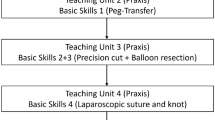Abstract
Background: The objective of this study is to investigate the role and significance of a hand-on program designed to teach laparoscopic skills.
Methods: The course consisted of 3 half days. In vitro training in suturing and knot tying was covered on the 1st half day, and live animal surgery on the 2nd and 3rd half days, respectively. In vitro suturing and knot tying of the 15 course participants were video-recorded and analyzed four times during the course, basing on the time required to mount a needle in the needle driver (M), driving the needle in a rubber glove (D), and knot tying (T).
Results: Laparoscopic skills which require two-hand coordination (M,T) were significantly improved by hands-on training. Needle driving skill appeared to be essentially the same as that needed for open surgery.
Conclusion: Hands-on training is an effective format particularly for laparoscopic skills in which two-hand coordination is essential.
Similar content being viewed by others
Author information
Authors and Affiliations
Additional information
Received: 3 April 1997/Accepted: 3 July 1997
Rights and permissions
About this article
Cite this article
Mori, T., Hatano, N., Maruyama, S. et al. Significance of ``hands-on training'' in laparoscopic surgery. Surg Endosc 12, 256–260 (1998). https://doi.org/10.1007/s004649900646
Published:
Issue Date:
DOI: https://doi.org/10.1007/s004649900646




